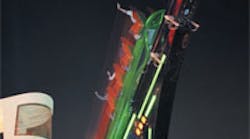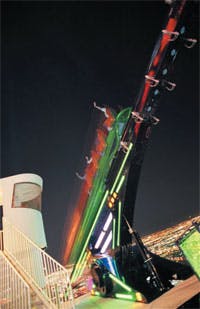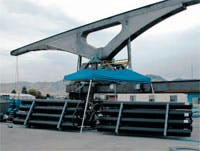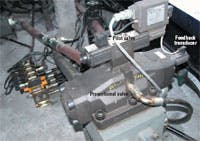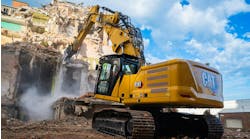Hydraulics, pneumatics bring riders a thrill in the X-Scream ride on top of Las Vegas' Stratosphere
Appeared in print as "Hydraulics goes over the edge"
Ride simulators have become the reality shows of entertainment attractions. They stimulate the senses, but any fear or other emotions they project are only experienced second-hand by the riders. So those who partake of simulator-type rides are more viewer than participant.
Thrill rides, on the other hand, can strike real fear into the participants. Even though riders know a 300-ft roller coaster is safe, there’s always that element of fear that this could be the one time something goes wrong. “People like to experience fear — as in horror movies and haunted houses,” says Bill Linkenheimer, former president of the American Coaster Enthusiasts. “Just as in those things, you know you aren’t really putting yourself in danger, but it’s a way of going out of control without risking your life.”
If participants knew how safe the rides were, they might not seem as frightening — and confronting fear is a big reason why many people subject themselves to thrill rides. Operators may assure you over and over that a ride is safe, but when you find yourself hundreds of feet from the ground, you have no choice but to trust your life to the safety of the ride.
A common fear is that of heights. Put people high enough in the air, and let them look down, and the situation gets pretty scary. The higher, and the less visible the safeguards, the scarier the ride. That’s the whole idea behind X-Scream, atop the Stratosphere Casino Hotel and Tower in Las Vegas. Because it’s at the top of the Stratosphere Tower, the X-Scream places riders nearly 900 ft above the Las Vegas Strip.
Extreme screams
Designed and built by Interactive Rides, Logan, Utah, the X-Scream works much like a giant teeter-totter. Bobby Ray Harris, senior vice president of operations at the Stratosphere, explains that an 80-ft long beam pivots at a central point to cause one end of the beam to rise while the other end lowers. Eight passengers get strapped into a car that rolls on a 78-ft track attached to the beam. Once seated, passengers find themselves tilted backward slightly at a 10° angle, looking out at a distant horizon.
When the ride begins, explains Clay Slade, president of Interactive Rides, a pair of hydraulic cylinders actuate to pivot the inward end of the beam upward by as much as 45°. The outward end, which extends beyond the outer edge of the Stratosphere Tower, pivots downward. With nothing to hold the car back, gravity pulls the car forward, so it rolls down the track and beyond the top surface of the Stratosphere tower.
Harris says that as the car descends beyond a certain point, riders cannot see the track beneath them — only the ground, 866 ft below. In fact, the wheels of the car are situated toward the back, so riders seated in the front of the car may actually feel as if they’ve traveled beyond the end of the beam.
Another terrifying aspect of the ride, continues Harris, is that the pivot point lies near the edge of the Stratosphere Tower. The car travels at 30 mph and is still accelerating when it passes beyond the edge of the Tower. When the car reaches the end of its travel, it is below and nearly 30 ft beyond the edge of the tower and tilted toward the ground.
So what keeps the car from rolling off the end of the beam and plunging nearly 900 ft below? Slade says a series of permanent magnets embedded in the beam brings the car to a controlled stop every time. Because the magnets produce magnetic fields at all times to stop the car, operation is 100% reliable even if all electrical power is lost. Furthermore, stopping is consistent under a wide range of weather conditions. And because stopping does not involve contact between parts, wear — and its associated maintenance — does not occur.
As if this isn’t enough, XScream delves out even more terror. Once the car reaches the end of its travel, the hydraulic cylinder retracts, hurling the beam skyward. This causes the car to roll backward, so the whole process can repeat. This process continues, seemingly at random, for a ride cycle of about one minute. Slade says the control computer contains more than 100 different ride programs, so no two consecutive rides are identical. And for those who dare, the ride program can pivot the beam so that the car plunges downward at 1 G acceleration, giving riders the feeling of weightlessness.
Hydraulics wreaks terror
The hydraulic system culminates in a pair of cylinders, one mounted one either side of the pivot point, to move the beam. The inboard cylinder (closer to the center of the tower) has a 7-in. bore and 48-in. stroke; the outboard cylinder has a 6-in. bore and 60-in. stroke. So to rock the beam, one cylinder extends as the other one retracts, and vice versa. With a system operating pressure of 2000 psi, the cylinders can generate more than enough thrust to heave the beam up or down at any commanded speed.
Slade says under normal circumstances, a pair of identical cylinders probably would have been mounted symmetrically. But circumstances of how the attraction is mounted to the tower made this assymetrical mounting necessary for proper load distribution.
Slade mentioned that Interactive Rides designed and built their own cylinders in this case. “The cylinders have a pretty sophisticated internal system to provide constant force cushioning. We’ve been designing our own custom cylinders for years, so we’ve developed a lot of expertise in that field.”
To monitor position, Slade says he opted for multiple resolvers on the beam itself rather than providing position feedback for the cylinders. “Ultimately, we need to know the position of the beam at all times. Using transducers in each cylinder could provide us with this information indirectly. But it just seemed simpler and more cost-effective to monitor the position of the beam directly.”
Plenty of power
Providing power for the XScream are two hydraulic power units, which were provided by Intermountain Hydraulics & Automation, Smithfield, Utah. Jeff Loosli, of Intermountain, says each of the 50- hp hydraulic power unit uses a Parker Hannifin PVP60 axial-piston pump. These variable-displacement pumps feature pressure compensation to maintain system pressure and are sized for a maximum displacement of 60 cc per revolution. Loosli says this translates to roughly 28 gpm when driven at a nominal speed of 1800 rpm.
